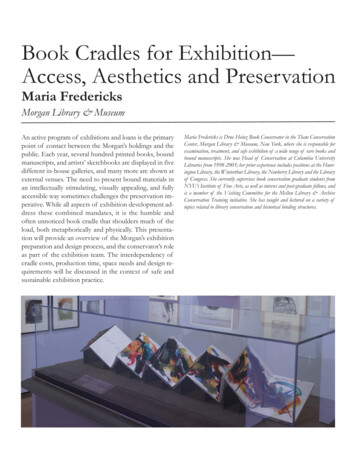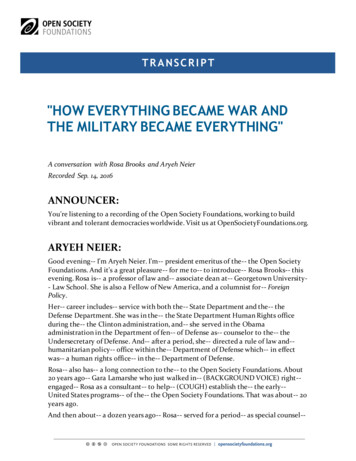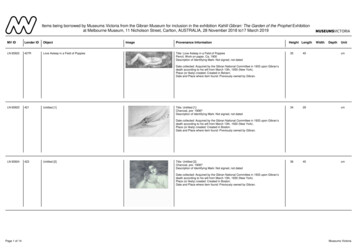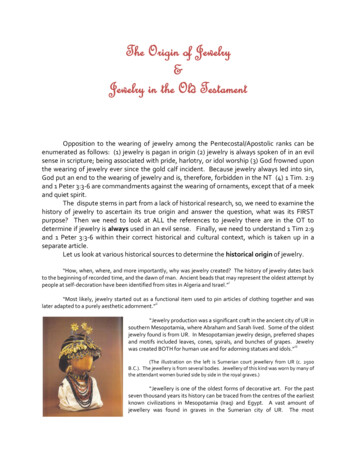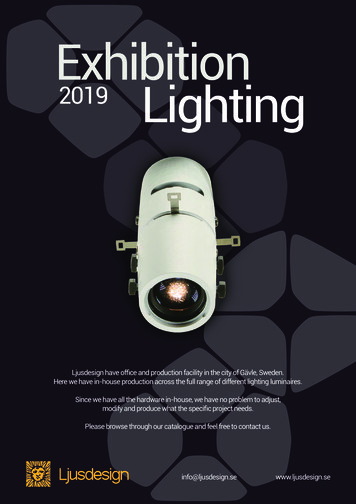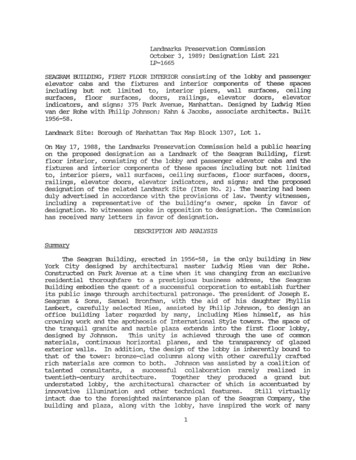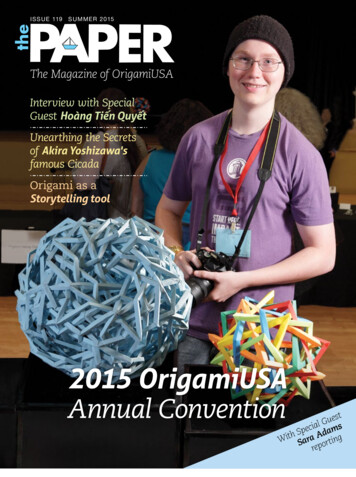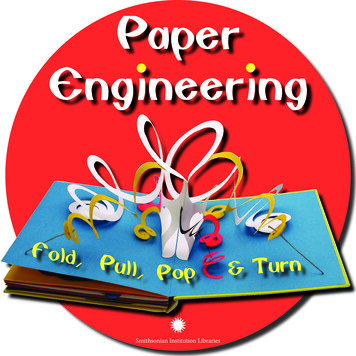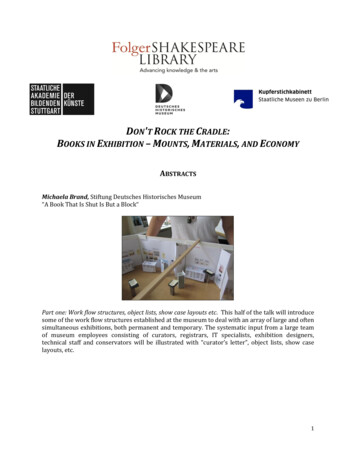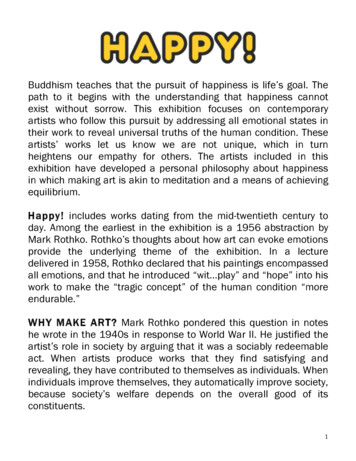
Transcription
Buddhism teaches that the pursuit of happiness is life’s goal. Thepath to it begins with the understanding that happiness cannotexist without sorrow. This exhibition focuses on contemporaryartists who follow this pursuit by addressing all emotional states intheir work to reveal universal truths of the human condition. Theseartists’ works let us know we are not unique, which in turnheightens our empathy for others. The artists included in thisexhibition have developed a personal philosophy about happinessin which making art is akin to meditation and a means of achievingequilibrium.Happy! includes works dating from the mid-twentieth century today. Among the earliest in the exhibition is a 1956 abstraction byMark Rothko. Rothko’s thoughts about how art can evoke emotionsprovide the underlying theme of the exhibition. In a lecturedelivered in 1958, Rothko declared that his paintings encompassedall emotions, and that he introduced “wit play” and “hope” into hiswork to make the “tragic concept” of the human condition “moreendurable.”WHY MAKE ART? Mark Rothko pondered this question in noteshe wrote in the 1940s in response to World War II. He justified theartist’s role in society by arguing that it was a sociably redeemableact. When artists produce works that they find satisfying andrevealing, they have contributed to themselves as individuals. Whenindividuals improve themselves, they automatically improve society,because society’s welfare depends on the overall good of itsconstituents.1
This exhibition looks at the use of archetypal images of happinesssuch as the smile, clouds, gifts, babies, and celebrations. Severalartists in the exhibition convey the power of music, dance, prayer,and positive psychology in their work, while others address theimplications of gift-giving, healing and play. The exhibition alsoexplores the bliss associated with Paradise before the Fall, infancy,and spiritual or meditative states. Although the artists included herehave not necessarily discovered the meaning of happiness, theirworks convey and thus generously share their pursuit of this elusivestate with the world. Exhibition curated by Director and ChiefCurator Bonnie Clearwater.#HAPPY EXHIBITIONThis exhibition is made possible by the generous support of Dr. David and Linda Frankel, theDavid and Francie Horvitz Family Foundation and Funding Arts Broward, Inc. Hotel Partner:The Dalmar Hotel. Special thanks to Rosa and Carlos de la Cruz and the de la Cruz Collection.Exhibitions and programs at NSU Art Museum Fort Lauderdale are made possible in part by achallenge grant from the David and Francie Horvitz Family Foundation. Funding is also provided by theCity of Fort Lauderdale, Wege Foundation, AutoNation, Community Foundation of Broward, paddockFamily Foundation, Funding Arts Broward, Broward County Board of County Commissioners asrecommended by the Broward Cultural Council and Greater Fort Lauderdale Convention & VisitorsBureau, the State of Florida, Department of State, Division of Cultural Affairs and the Florida Councilon Arts and Culture. NSU Art Museum Fort Lauderdale is accredited by the American Association ofMuseums.All content and text in this document copyright 2020 NSU Art Museum Fort Lauderdale.2
LINK TO VIRTUAL TOURThe text labels follow the virtual -on-view/ATRIUMFriendsWithYou (Art collaborative founded 2002, Miami, FL;active in Los Angeles, CA)Into the Clouds, 2019Ripstop nylon120 x 75 x 90 inches eachCourtesy of FriendsWithYouFriendsWithYou is the fine art collaborative of Samuel Borkson andArturo Sandoval III, working together since 2002. They aim to usetheir multi-media works to spread the positive message of “Magic,Luck, and Friendship.TM” Their process encompasses the healingarts, modern rituals, animism, and recognizable symbols as ameans “to prompt a wide spectrum of emotions from playfulness toself-reflection.” For the past 17 years, their work has focused on thecontemporary art practice “relational aesthetics” that spreadspositive intentions to affect culture. Their work has traveled theglobe, and the artists are considered pioneers in the field ofexperiential art. Their fully immersive installations serve as culturalhappenings that inspire compassion, joy and communalinteractions. FriendsWithYou has also adapted its philosophy to anumber of mass media applications, most notably their Netflixseries, True and the Rainbow Kingdom.NSU Art Museum commissioned this installation for the exhibitionHappy!, consisting of three enormous inflatables of3
FriendsWithYou’s character Little Cloud. The artists gave LittleCloud the features of a baby to trigger the viewer’s desire to protectand love an infant. Inspired by the Macy’s Thanksgiving Day Paradeand its enormous balloon floats, the artists staged a parade withinflatables of icons along with a curated group of friends, on MiamiBeach to coincide with the international art fair Art Basel MiamiBeach in 2006. FriendsWithYou’s inflatables also follow in thetradition of other works in this exhibition, including Andy Warhol’s1966 Silver Cloud installation of helium-filled silver Mylar pillows,and Jeff Koons’s porcelain balloon sculptures. FriendsWithYou’sgravity-defying inflatables contradict sculpture’s traditionalproperties of weight and density. Consequently, viewers are morelikely to associate them with children’s toys and play than withconventional sculpture. However, the medium is suited to theartists’ intentions, as they describe their floating Little Cloud as asymbol to move the anxious viewer to a relaxed and joyous state byoffering a positive message of happiness and connectivity to all ofhumankind.FriendsWithYou’s icons Little Cloud and Rainbow (on view in thesecond-floor Introductory Gallery) made their debut as giantballoons in the Macy’s Thanksgiving Day Parade in November2018.4
ARTIST ds/2019/10/HAP 5509-1030x691.jpgFriendsWithYou (Art collaborative founded 2002, Miami, FL;active in Los Angeles, CA)The Boy, 2004Artificial leather, polyester filling12 x 6 1/4 inchesThe Collection of Kathryn and Dan MikesellKAWS (b. 1974, Jersey City, NJ; lives and works in Brooklyn, NY)Brown COMPANION, 2006COMPANION: Passing Through (Gray), 2013Pinocchio and Jiminy Cricket, 2010Small Lie (Black), 2013Vinyl cast resin11 x 5 x 3 inches, 11 x 6 ½ x 7 ½ inches, 10 x 5 x 5 inches, 10 ¾ x 5 x 5 inchesCourtesy of the Forman FamilyIn 1986, New York artist Keith Haring opened the Pop Shop indowntown Manhattan. Haring considered the Pop Shop as anextension of his work, a fun boutique where his art could beaccessible to everyone as affordable clothing, posters, and giftitems emblazoned with his unique iconic images. Several of theartists in the Happy! exhibition, including FriendsWithYou, KAWS,Jeff Koons, Takashi Murakami, and Kenny Scharf, similarly aim toreach a broad audience by blurring traditional boundaries betweenart, commerce, and popular culture. Their work is equally at homein art museums and galleries as in the luxury brand market. Theirwork may appear as public graffiti, advertising on billboards,cartoons, playgrounds and even as giant balloons for the Macy’sThanksgiving Day Parade in New York City. Displayed here is aselection of limited edition vinyl toys by KAWS and a soft sculptureby FriendsWithYou.5
Takashi Murakami (b. 1962, Tokyo, Japan; lives and works inTokyo and New York)Louis Vuitton Bag, 2007Canvas, leatherPrivate Collection, MiamiJapanese artist Takashi Murakami provocatively incorporated aluxury boutique operated by Louis Vuitton into his 2007retrospective at the Museum of Contemporary Art, Los Angeles.Murakami’s alliance with luxury brands is another avenue to spreadhis message to the public. Luxury goods build his brand as an artist,while serving as a critique of consumer culture—the happiness oneachieves through acquiring material goods is fleeting.6
INTRODUCTORY 2019/10/HAP 5513-1-1030x508.jpgFriendsWithYou (Art collaborative founded 2002, Miami, FL;active in Los Angeles, CA)Rainbow Gate, 2019Vinyl inflatable and LED lights159 x 276 x 27 ½ inchesCourtesy of FriendsWithYouFelix Gonzalez-Torres (b. 1957, Guáimaro, Cuba; d. 1996,Miami, FL)“Untitled”, 1989/1990Print on paper, endless copiesOverall dimensions: 26 x 56 x 23 inches“Untitled” (Portrait of Dad), 1991White candies individually wrapped in cellophane, endless supplyBoth works Courtesy of The Felix Gonzalez-Torres Foundation; Collection Rosa & Carlos de la Cruz,Key Biscayne, FLFelix Gonzalez-Torres’s work is completed by the audience (muchlike the work of conceptual artist Yoko Ono and FriendsWithYou,also on view in this exhibition). His work gives viewers the choice totake a piece of the work with them, like a gift. His candy spill workscan be interpreted in any number of ways and the meaning canshift each time they are considered by new audiences. While theseworks might be understood as a way of addressing loss; GonzalezTorres’s mother, father, and partner all died within a brief periodand the artist, diagnosed with AIDS, was facing his own mortality,the works can also be interpreted as exploring themes ofabundance and regeneration.All art, in a sense, is concerned with death, the universal human7
condition. Portraits and still lives (nature morte—dead nature) keeptheir subjects alive, while artists live on through their work. Some ofGonzalez-Torres’s candy spills can be seen as unconventionalportraits, such as “Untitled” Portrait of Dad. The spill can slowlydiminish as viewers choose to take the candy but the possibilityalways exists for the exhibitor to replenish the candy.Viewers participating in this work may be motivated to meditate onthe inevitability of death, associating the reduction of the spill withthe way a person’s time on earth diminishes daily; while thereplenishment of the spill suggests how art and memory keep lovedones alive. The taste of the candy may also remind the viewer of thesweetness of life.Also on view is Gonzalez-Torres’s “Untitled”, 1989/1990, twostacks of paper displayed side by side. The phrase “Somewherebetter than this place,” is printed on the sheets of paper on onestack, while “Nowhere better than this place” is printed on theother. The viewer may choose to take individual sheets from thestacks, which, like the candy spill, can also be replenished.Gonzalez-Torres said of his work and purpose in life:“It might not be the best idea, but I’m still proposing the radicalidea of trying to make this a better place for everyone. That’s reallywhat I’m all about. I trust that agenda.”Kathryn Andrews (b. 1973, Mobile, AL; lives and works in LosAngeles, CA)Gift, 2011Serigraphs44 x 232 inchesCollection of Rosa and Carlos de la Cruz, Key Biscayne, FLKathryn Andrews frequently complicates the ways of looking andresponding to a work of art by combining figurative and abstract8
elements and referencing Pop art and minimalism. In this work, shetransforms a minimalist abstract composition into gift-wrappedpackages by embellishing its surface with printed metallic bows.She thereby equates minimal painting and gifts as objects thatarouse desire. A gift concealed within festive wrapping heightensthe recipient’s anticipation and imagination, much like a newlyencountered artwork stimulates the viewer visually, emotionally andintellectually. Art and gifts are enigmas waiting to be unwrapped.Both also operate within an economic framework that generatesa range of emotions as their worth exceeds their intrinsic value. Butgifts, unlike art, also operate within an economy of guilt as therecipient remains indebted to the gift-giver, not only for themonetary value of the gift, but also for the emotions he or sheinvested in it.Kenny Scharf (b. 1958, Los Angeles, CA; lives and works in LosAngeles, CA)Cosmic Cavern, 2019Found objects, day-glo paint144 x 192 inchesCourtesy of the ArtistEnter through the black curtain behind the yellow wallKenny Scharf provides the viewer with a mind-altering experience inhis Cosmic Cavern, an immersive day-glo, multi-sensory installationthat mixes Pop art and Surrealism with the hedonistic 1980s cluband disco culture. He assembled his first such installation in 1981in a closet of the New York apartment he shared with artist KeithHaring (whose work is also included in this exhibition). Scharf, likeHaring, brought a playful approach to “high art” that aimed to makeit more widely accessible. Nevertheless, his work was swiftlyembraced by the art world, with invitations to create large scaleinstallations at the Whitney Museum of American Art for its 1985Biennial, and other major art institutions. In this respect, Scharf’s9
work is a forerunner to the subsequent generation of artists in thisexhibition, including KAWS and FriendsWithYou.Samson Kambalu (b. 1975, Malawi, Africa; lives and works inOxford, England)Moses (Burning Bush), 2015VideoRunning time: 32 secondsNSU Art Museum Fort Lauderdale; purchased with funds provided by Michael and Dianne Bienes byexchange, 2016.8Malawi-born Samson Kambalu addresses the gift-giving economy ofhis small African country. Malawians incorporated gift-exchange intotheir festivals, during which gifts were distributed by maskedparticipants, in order to avoid encumbrance of the impliedexpectation of reciprocity. The joy of these festive occasionsextended into everyday life.In Kambalu’s youth, the masks that were essential to thesefestivals were moved to museums. The tradition of mask-wearingand play, observed Kambalu, was naturally transferred to the newamusement centers, the village cinema, where old films andprojectors would constantly break down during screenings. In orderto keep the audience entertained, the projectionists would quicklyedit the film, sometimes combining more than one movie, whichwould disrupt the original narrative. These films generated the thrillof participating in the masked festivals, and similarly promptedaudiences to be generous in everyday life.Gift-giving, the aesthetic of experiencing the cut and spliced films ofhis youth, and his study of the history of cinema inspired the shortfilms in Kambalu’s Nyau Cinema series. Each of his films follows aset of rules that the artist established. Kambalu perceives his NyauCinema as the embodiment of his society’s philosophy. As he notes,10
his films are gifts to the viewer, as he believes that the “work of theartist today is to remind people what it means to give.”Kambalu generally films himself enacting simple gestures that arepresented as a continuous loop. In Moses (Burning Bush), heencounters an enflamed tree, which, like the biblical burning bushfrom which an angel of the Lord called out to Moses, is neverconsumed by the fire. The intensity of this vision knocks Kambalu’shat off his head. This film addresses the miraculous, awe-inspiringmoments in the physical world or in art that bring great joy andprovide meaning in life.11
GALLERY TWO:ICONS OF s/2019/10/HAP 5644-1030x719.jpgWestern philosophy, Buddhism, and many religions including theJudeo-Christian tradition encourage us to seek happiness fromwithin and to forgo attachment to physical things. Nevertheless,tangible objects and images give rise to feelings of joy, happinessand the spiritual. Some of these visual stimuli are culturallyconstructed while others embody universal qualities that triggerpleasurable responses.Several works in this exhibition employ tangible objects and imagesas icons of happiness to elicit an emotional response from theviewer. Among these stimuli are:Yellow: The color yellow is the brightest color of the visiblespectrum. As the color of radiant sunshine, it is associated withhappiness, optimism and joy.Rainbow: As a meteorological phenomenon, rainbows fill us withawe. They are symbols of peace, serenity and hope.Pandas: These large bears symbolize peace, gentleness, good luck,and positive thoughts.Clowns: These buffoonish entertainers symbolize fun, frivolity, andhappiness.Smile: The smile is an expression of joy, happiness, andamusement. When the brain is stimulated to release endorphins, ittransmits signals to the facial muscles to trigger a smile.12
Happy Face: This stylized icon, designed by American graphic artistHarvey Ross Ball in 1963, consists of a solid yellow circle with twoblack ovals for eyes, and a thin black arc of a grin.Happy Face Emoji: Pictographs representing various emotions arecreated using basic punctuation marks; the smiling face is createdwith a colon for eyes and right parenthesis for the smile (a dash isalso used for the nose). These pictographs have been transformedinto a full range of emojis to represent emotional nuances in digitalmessaging.Flowers: Although specific flowers have been assigned varioussymbols in different cultures, flowers have been shown to improvepeople’s mood through their association with nature. They stimulatethe brain’s sense of excitement in anticipation of a specialoccasion.Clouds: White clouds symbolize happiness, joy, and equilibrium. Tobe “on cloud nine” is to be in a state of blissful happiness, whileeven dark clouds are said to have “a silver lining.”Buoyancy: floating balloons, clouds, and bubbles provide a sense ofeuphoria.13
Keith Haring (b. 1958, Reading, PA; d. 1990, New York, NY)Untitled (Pink Smiling Face), 1981Baked enamel on metal48 x 48 inchesPrivate Collection Courtesy The Brant Foundation, Greenwich, ConnecticutKeith Haring was known for his whimsical, graffiti-infusedcalligraphic style of drawing and painting. Carefree cartoon imagerysubversively conveyed Haring’s activism and commitment to antinuclear proliferation, racial equality, LGBTQ causes, and AIDSawareness.The three-eyed smiling face is one of the motifs that frequentlyappears in his work. He reportedly developed this image byaccident as he had left too much room between two eyes, which hefilled by adding a third. The quixotic face has been interpreted assuggesting the enlightenment associated with the third eye ofDharmic spiritual traditions, clairvoyance, and religious visions. Itcan also represent happiness or greed. Haring, however, did notshare his own meaning of this or most other emblems as he feltthey should remain open for interpretation.Haring was diagnosed with AIDS in 1988 but continued making artuntil the end of his life in 1990. His sister shared in her brother’seulogy how this diagnosis made him appreciate the preciousness oflife. He told her that “you never know when you’re doing somethingfor the last time, so you live each day like it is the last.”Keith Haring (b. 1958, Reading, PA; d. 1990, New York, NY)Untitled (For Salvatore), 1984Acrylic on glass78 ½ x 58 ½ inchesPrivate Collection, Florida14
Takashi Murakami (b. 1962, Tokyo, Japan; lives and works inTokyo and New York)Open Your Hands Wide, Embrace Happiness!, 2010Acrylic and platinum leaf on canvas70 7/8 x 70 13/16 inchesPrivate Collection, Courtesy of Sabsay Gallery DenmarkFrom an early age, Takashi Murakami was enamored of Japaneseanime (cartoon animation) and manga (comic books). He attendedTokyo University of the Arts where he studied traditional Japaneseart and techniques and mastered Japanese flower painting.During his first trip to New York in the late 1980s, Murakamiimmersed himself in Western contemporary art, including visiting aretrospective of the German painter Anselm Kiefer, Jeff Koons’sexhibition of kitschy objects, and Julian Schnabel’s enormouspaintings that vary between abstraction and figuration. He observedhow these artists’s works addressed Western art traditions,particularly its progression from figuration toward abstraction, andthe valuing of high art over craft and popular culture. In Japan,however, all forms of artistic expression are valued equally, andpictorial space in Japanese art was rendered atmospherically or asflat patterns rather than through linear perspective that informedWestern art from the 16th century to the late-19th century (see linkto image below)Murakami coined the term Superflat to define hiswork, which embodies the Japanese tradition of flat pictorial space,the two-dimensional imagery of anime and manga, and theequalizing or flattening of the distinction between “high art” andpopular culture.This painting with its multitude of cartoonish smiling flowers isdeceptively complex (there is one partially hidden crying flowerlocated right of center, suggesting an underlying sadness that ismasked by the smiling flowers). The title Open Your Hands Wide,15
Embrace Happiness! reads like a positive aphorism or Buddhistteaching. But it also resonates as an authoritarian commandinvoking Japan’s 1946 Constitution, Article 13, which stipulates,“(People’s) right to life, liberty and the pursuit of happiness shall, tothe extent that it does not interfere with the public welfare, be thesupreme consideration in legislation and other government affairs.”Murakami was born in 1962, and his world view was shaped by hisresponse to post-World War II Japan’s fixation on happiness. Hecontends that the Japanese never fully examined their militaryaggression in the war, or the trauma of the atomic-bombing of twoof its cities and subsequent American occupation. Their collectiveanxious psyche found an outlet in popular culture’s fascination withmonsters such as Godzilla and infantilization in which the sense ofpowerlessness is soothed by cute characters such as Hello Kitty.Murakami’s crowded fields of happy flowers embody this critique ofhis nation’s pursuit of happiness at the expense of self-reflection.Katsushika Hokusai (b. 1760, Edo [now Tokyo], Japan; d. 1849, Edo [now Tokyo], Japan)Wantanabe No Gengo Tsuna and Iokuma Nyudo Eaiun, from an untitled series of Warriors in Combat,c. 1833-35Woodblock print, ink and color on paperMuseum of Fine Arts Boston; William Sturgis Bigelow -from-anunt?ctx 734184a0-1d9e-48a0-ab6d-557dbf212f52&idx 175Ernesto Neto (b. 1964, Rio de Janeiro, Brazil; lives and works inBrazil)Matter and Figures, 2009Plastic net, plastic pearls, and plastic toys89 3/8 x 23 5/8 x 6 ¼ inchesNSU Art Museum Fort Lauderdale; gift of Rita Krauss, 2018.30Since the mid-1990s, Ernesto Neto has produced an influentialbody of work that explores constructions of social space and thenatural world. Drawing from biomorphism and minimalist sculpture,16
Neo-concretism and other Brazilian vanguard movements of the1960s and 1970s, Neto’s core themes are gravity, sensation,nature, and the body. In this work, Neto filled the extremities of aplastic net with small plastic toys. The netting is slung over a beamso that the two pouches bulge at each end like pendulouscornucopia, thereby creating a tension between weight, gravity andbalance. This work was inspired by Neto’s experience of how hischildren filled his life in new and unexpected ways, such as thetransformation of their home into a world brimming with plasticcolored toys.Jeff Koons (b. 1955, York, PA; lives and works in New York, NY)Balloon Monkey (Blue), 2017Balloon Rabbit (Red), 2017Balloon Swan (Yellow), 2017Porcelain with chromatic coating9 13/16 15 7/16 8 ¼ inches; 11 ½ 8 ¼ 5 ½ inches; 9 ½ x 6 3/8 x 8 ¼ inchesNSU Art Museum Fort Lauderdale; purchased with funds provided by Michael and Dianne Bienes byexchangeJeff Koons’s works blur the definitions of “high art,” popular cultureand kitsch. They have had a significant influence on several artistsin this exhibition, including Takashi Murakami, KAWS,FriendsWithYou and Alake Shilling, who similarly referencechildhood toys and cartoon characters to engage the viewer’semotions. Inspired by his own happy childhood, Koons bases hismasterfully produced sculptures on cute plastic inflatable toys andballoon animals. As balloon animals are among the earliest formsof sculpture encountered by children, Koons’s whimsical works maytrigger happy memories.Although the works on view mimic shiny Mylar toy balloons thathave been inflated with air and twisted into the shape of a monkey,swan and rabbit, they are actually finely crafted porcelain figurines17
polished to a mirror-smooth patina; and while balloons areephemeral, these figurines remain permanently flawless. Moreover,as the balloon animal sculptures look malleable and hollow, theycontradict traditional properties associated with sculpture—weightand density. Brightly colored, friendly, and erotically suggestive,these sculptures seem to pose no threat to viewers except,perhaps, to their definition of the nature of art. Koons, however,discourages viewers from fretting over whether they shouldappreciate his work as high art or kitsch. Whatever the viewer’sresponse, is just “fine.”Koons associates the balloons with life, stating, “I’ve alwaysenjoyed balloon animals because they’re like us. We’re balloons.You take a breath and you inhale, it’s an optimism. You exhale, andit’s kind of a symbol of death.”Rob Pruitt (b. 1964, Washington, DC; lives and works in NewYork, NY)Untitled, 2012Glitter and enamel on canvas70 7/8 x 70 13/16 inchesCourtesy of Isabel and Ricardo ErnstRob Pruitt has been painting giant pandas as a subject for over 18years. He was attracted to these cuddly, universally belovedcreatures, as a means of engaging the viewer emotionally. He alsofound the pandas’ distinctive black and white markings appealingas abstract compositions. This painting can be read simultaneouslyas representing two pandas embracing before a sunset, or as anabstract composition of contrasting patterns of black and white,and a gradient flat colorfield. Emotions are thereby stimulated twoways: the precious depiction of two loving pandas and theexcitement of an abstract painting.18
Rob Pruitt (b. 1964, Washington, DC; lives and works in NewYork, NY)Us, 2013Acrylic, enamel, and flocking on linenEach (66): 29 ½ x 23 ½ inches; Each (66): 31 ½ x 25 inchesCourtesy of Rosa and Carlos de la Cruz, Key Biscayne, FLRob Pruitt associates giant pandas (the stars of the National Zoo,since the early 1970s) and Mark Rothko’s colorfield paintings withhis youth in Washington, D.C. He especially cherishes his visits tothe National Gallery of Art where he recalls being overcome withemotion standing in front of Rothko’s abstract paintings and hisfather jokingly suggesting whether it would have been better if theartist had drawn a face over them. By painting a spectrum ofgestural facial expressions onto his candy-colored gradientcanvases, Pruitt transformed these tender moments with his fatherinto a universal experience (emphasized by titling the work Us) toshare with viewers of his work.Mark Rothko (b. 1903, Russia [now Latvia]; d. 1970, New York,NY)Untitled, 1956Oil on canvas65 ¼ x 40 5/8 inchesNational Gallery of Art, Washington, Gift of The Mark Rothko Foundation, Inc., 1986.43.160Mark Rothko’s thoughts about the nature of emotion in art providethe underlying subject of this exhibition. In a lecture he delivered in1958 to art students at the Pratt Institute in New York, he declaredthat he intended his abstract paintings to encompass the full rangeof emotions, and that he introduced “wit and play” and an elementof “hope” into his work to make the “tragic concept” of the humancondition “more endurable.” He admitted that he was particularlyplayful with the edges of shapes in his paintings. Indeed, the19
extremities of these rectangular forms are alive with featherybrushstrokes and the overlapping of washes of color, that producea vibration in which the forms seem to grow and shrink before theviewer’s eyes. We see this in Untitled, 1956, which is alsodistinctive for the irregular profile of the upper most rectangularform. Typically, Rothko’s paintings have regular rectangular forms,but, in this painting there is a rather comical undulation at the topof the area of blue, showing that he continued to experiment—orplay—with the edges of forms well into the 1950s.The color combination of vivid red, blue and yellow of Untitled,1956, is exceptional for Rothko’s paintings of the early 1950s,which tend to be painted either in muted pastels or combinations ofvibrant oranges, yellows, magenta, white and black. One of the fewpaintings that shares its palette is his 1954 Homage to Matissepainted following the French artist’s death. Like this earlier homageto the master of wild colors, Untitled, 1956, is strikingly similar tothe colors in Matisse’s Le bonheur de vivre (Joy of Life), 1905,which suggests Rothko was aiming to convey the joy of life in hispainting (see link to Matisse’s painting below). Also included in thisexhibition is an early figurative painting by Rothko depicting achildren’s celebration (located in Gallery Five). Titled The Party, thiswork is likewise resplendent in the high-key palette of red, blue, andyellow, further suggesting that Rothko associated this colorcombination with moments of joy.Rothko proposed that artists have the ability to produce work that ismiraculous and as much of “a revelation” for the viewer as for theartist.Henri Matisse (b. 1923, New York, NY; d. 1997, New York, NY)Le bonheur de vivre (Joy of Life), 1906Oil on canvas69 1/2 x 94 3/4 inchesBarnes oy-of-Life/20
Alma Thomas (b. 1891, Columbus, GA; d. 1978 Washington, DC)Night Sky Mysteries, 1973Acrylic on canvas68 x 54 inchesMiami-Dade County Art in Public Places Trust, Public Art CollectionAlma Thomas, a contemporary of Mark Rothko, lived and workedprimarily in Washington, D.C., where she was an importantparticipant in the Capital’s Color School movement. Thomas, alongwith Gene Davis, Sam Gilliam, Morris Louis, and Kenneth Noland,among other artists associated with the Color School, exploredcreating abstract
exhibition have developed a personal philosophy about happiness in which making art is akin to meditation and a means of achieving equilibrium. Happy! includes works dating from the mid-twentieth century to day. Among the earliest in the exhibition is a 1956 abstraction by Mark Rothko. Rothko’s t

